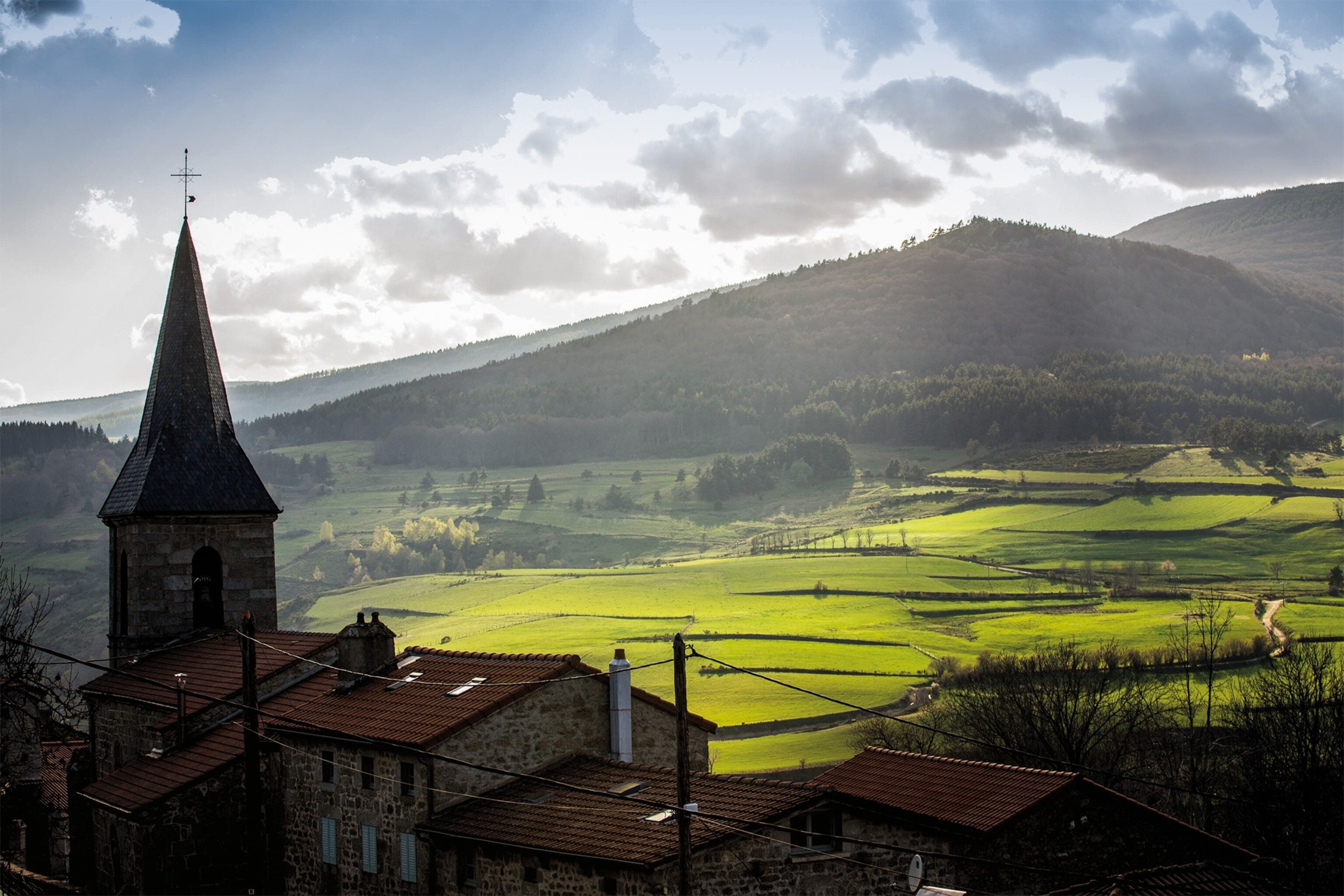Did a 'werewolf' really terrorize France in the 1700s?
The savage 'Beast of Gévaudan' rampaged across the French countryside between 1764 and 1767 and killed as many as a hundred people. The true nature of the attacks and the creature itself remains a mystery.

Jeanne Boulet, a fourteen-year-old shepherd girl, was tending livestock in the wooded valleys near the Allier River in the Gévaudan region of central southern France one day in June 1764. Her badly injured body was later discovered, the victim of an apparent wolf attack. Her death did not seem unusual at the time. Children often shepherded sheep or cattle by themselves, and wolves were part of the hazards of rural life.
More fatalities like Boulet’s followed with severe injuries, dismemberments, and even decapitations. Whatever this deadly creature was, it was far more ferocious than a regular wolf. As whispers of a werewolf began to circulate, the deadly creature became known as la bête, the beast.
(These imaginary beasts fueled nightmares around the world.)
It would terrorize Gévaudan for three years, killing as many as 100 people (although some sources claim the total could be as high as 300). Between 1764 and 1767 more than a hundred wolves were killed in Gévaudan, but scholars are still trying to determine if any of them was the deadly beast responsible for the attacks.

Savage attacks
The historic Gévaudan county, situated in the rugged highlands of the Massif Central, straddles France’s Auvergne and Languedoc regions. It is a dramatic, forbidding land of dense forests and rain-drenched plateaus. Gévaudan had once been prosperous, but the wars of the 16th century had battered the rural economy. Many locals were extremely poor and subsisted by herding livestock.
After Boulet’s death and the following half dozen cases, young shepherds banded together in groups, but the beast was not deterred by their numbers. The savage attacks continued, taking the lives of mostly women and children. By the fall of 1764, word of the terrifying monster had spread far beyond Gévaudan to the rest of France.
The beast became a national obsession thanks to the editor of the Courrier d’Avignon, François Morénas. The end of the Seven Years’ War with Britain in 1763 had caused a news drought for Morénas. Successful in peddling sensationalist stories, Morénas printed stories of the Beast of Gévaudan to boost the newspaper’s sales and spread word of the creature around the nation.

These attacks generated dread, which was stoked further by the dramatic reporting of Morénas’s correspondents. One such report attributed astonishing swiftness to the beast. Another said that it had the gaze of a devil. Others reported that it possessed the intelligence of a “wily, robust and skilled gladiator.” In late 1764 Morénas’s publication was comparing the beast to the mythical Nemean lion and other terrifying monsters.
(Discover 24 spooky places to visit around the world.)
In addition to horrific accounts of the beast itself, the newspapers also printed survivors’ accounts of their encounters. In January 1765 a group of preteens held the creature at bay with sticks. In another incident in March, Jeanne Jouve fought to protect her three children; one of them, age six, died from his injuries. One of the most famous was Marie-Jeanne Vallet, the “Maiden of Gévaudan” who fought the beast off, wounding it in the chest with a bayonet.
On the hunt
For some, the challenge to catch the beast represented a good career move, and a shot at redemption. A local military captain Jean-Baptiste Duhamel recruited thousands of local people to help him hunt down the beast in fall 1764. Based on reports of the long black stripe down its back, Duhamel speculated that the beast was not a wolf, but a big cat: “This animal is a monster whose father is a lion; it remains open what the mother is.” Despite his best efforts, Duhamel failed to capture the monster.

By early 1765 the continuing Gévaudan drama had attracted the attention of King Louis XV. He rewarded the group of boys who had fought off the beast with sticks and gave their leader a free education. In March the king sent his own hunters to trap the beast. A renowned Normandy wolf hunter, Jean-Charles Vaumesle d’Enneval, was appointed to head the mission, but he, too, was unsuccessful.
Rattled by his appointee’s lack of progress, Louis XV sent his bodyguard, the veteran soldier François Antoine. On September 21, 1765, Antoine’s men killed a large wolf that they believed to be the beast. The body was sent to Paris, and Antoine was rewarded.
Two months later, however, the attacks resumed. Between December 1765 and June 1767, as many as 30 more fatalities were reported. Fear stalked the Gévaudan once again, except this time, the locals were on their own. Embarrassed by their failure, the authorities paid little attention, and even the newspapers, had lost interest.

On June 19, 1767, local hunter Jean Chastel shot and killed a large animal. From then on, the attacks stopped. Witnesses described the fallen creature as a wolf, but a strange one: It had a “monstrous” head, and a coat of red, white, and gray that hunters had not seen on wolves before.
Mystery monsters
In the following centuries, different explanations were investigated as to the cause of these horrific deaths in the Gévaudan region. One of the most popular was supernatural in origin: the werewolf. Science has ruled that one out, but the legend lingered for many years, perhaps because of the rumor that Chastel shot the Beast of Gévaudan with a silver bullet.
Recent theorists have speculated that a serial killer could have been at work in Gévaudan who employed some sort of animal to help them kill their victims; however, most experts think this idea is too far-fetched.
(Ghost stories scare up new life at these historic hotels.)
The answers with the most support come from the animal world. Others suggested the beast could have been an escaped creature that was not native to France, like a hyena. Biologist Karl-Hans Taake has recently argued that the beast was an escaped juvenile male lion, whose immature mane would have looked strange to inhabitants of the French countryside. According to Taake, the lion eventually died after eating poisoned bait, which had been placed throughout the Gévaudan region.

Historian Jay M. Smith has proposed a less exotic theory: The“Beast” of Gévaudan was rather likely to be several large wolves. The distorting lens of the press and subsequent national hysteria created the Beast of Gévaudan and the hype that went with it.
Writing more than a century after the last attack, Robert Louis Stevenson (future author of Treasure Island) was traveling through Gévaudan and described his dismay at how the world was changing: “This was the land of the ever-memorable Beast, the Napoleon Bonaparte of wolves.” Now that the railroad was arriving, “you may not meet with an adventure worth the name.”
The modern world may have crept into Gévaudan, but the true identity of the beast will most likely never be solved to anyone’s satisfaction, lending a permanent air of mystery to this wild region of the Massif Central.
You May Also Like
Go Further
Animals
- This ‘saber-toothed’ salmon wasn’t quite what we thoughtThis ‘saber-toothed’ salmon wasn’t quite what we thought
- Why this rhino-zebra friendship makes perfect senseWhy this rhino-zebra friendship makes perfect sense
- When did bioluminescence evolve? It’s older than we thought.When did bioluminescence evolve? It’s older than we thought.
- Soy, skim … spider. Are any of these technically milk?Soy, skim … spider. Are any of these technically milk?
- This pristine piece of the Amazon shows nature’s resilienceThis pristine piece of the Amazon shows nature’s resilience
Environment
- This pristine piece of the Amazon shows nature’s resilienceThis pristine piece of the Amazon shows nature’s resilience
- Listen to 30 years of climate change transformed into haunting musicListen to 30 years of climate change transformed into haunting music
- This ancient society tried to stop El Niño—with child sacrificeThis ancient society tried to stop El Niño—with child sacrifice
- U.S. plans to clean its drinking water. What does that mean?U.S. plans to clean its drinking water. What does that mean?
History & Culture
- Séances at the White House? Why these first ladies turned to the occultSéances at the White House? Why these first ladies turned to the occult
- Gambling is everywhere now. When is that a problem?Gambling is everywhere now. When is that a problem?
- Beauty is pain—at least it was in 17th-century SpainBeauty is pain—at least it was in 17th-century Spain
- The real spies who inspired ‘The Ministry of Ungentlemanly Warfare’The real spies who inspired ‘The Ministry of Ungentlemanly Warfare’
- Heard of Zoroastrianism? The religion still has fervent followersHeard of Zoroastrianism? The religion still has fervent followers
Science
- Here's how astronomers found one of the rarest phenomenons in spaceHere's how astronomers found one of the rarest phenomenons in space
- Not an extrovert or introvert? There’s a word for that.Not an extrovert or introvert? There’s a word for that.
- NASA has a plan to clean up space junk—but is going green enough?NASA has a plan to clean up space junk—but is going green enough?
- Soy, skim … spider. Are any of these technically milk?Soy, skim … spider. Are any of these technically milk?
- Can aspirin help protect against colorectal cancers?Can aspirin help protect against colorectal cancers?
Travel
- What it's like to hike the Camino del Mayab in MexicoWhat it's like to hike the Camino del Mayab in Mexico
- Follow in the footsteps of Robin Hood in Sherwood ForestFollow in the footsteps of Robin Hood in Sherwood Forest
- This chef is taking Indian cuisine in a bold new directionThis chef is taking Indian cuisine in a bold new direction
- On the path of Latin America's greatest wildlife migrationOn the path of Latin America's greatest wildlife migration
- Everything you need to know about Everglades National ParkEverything you need to know about Everglades National Park







